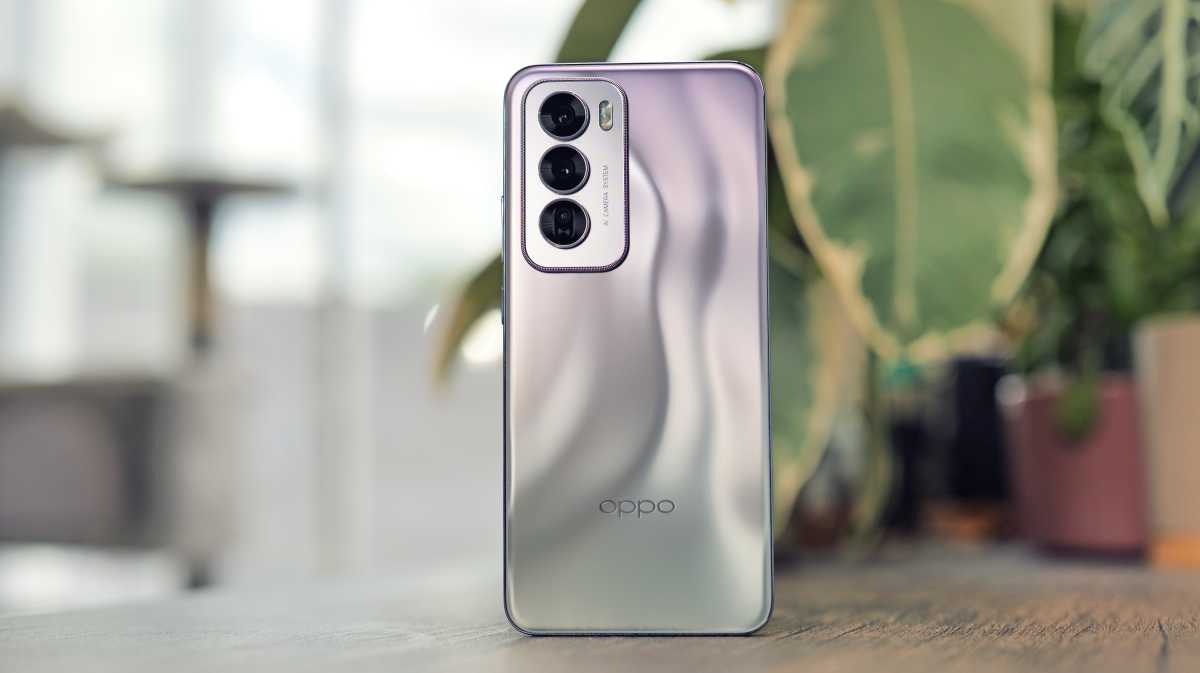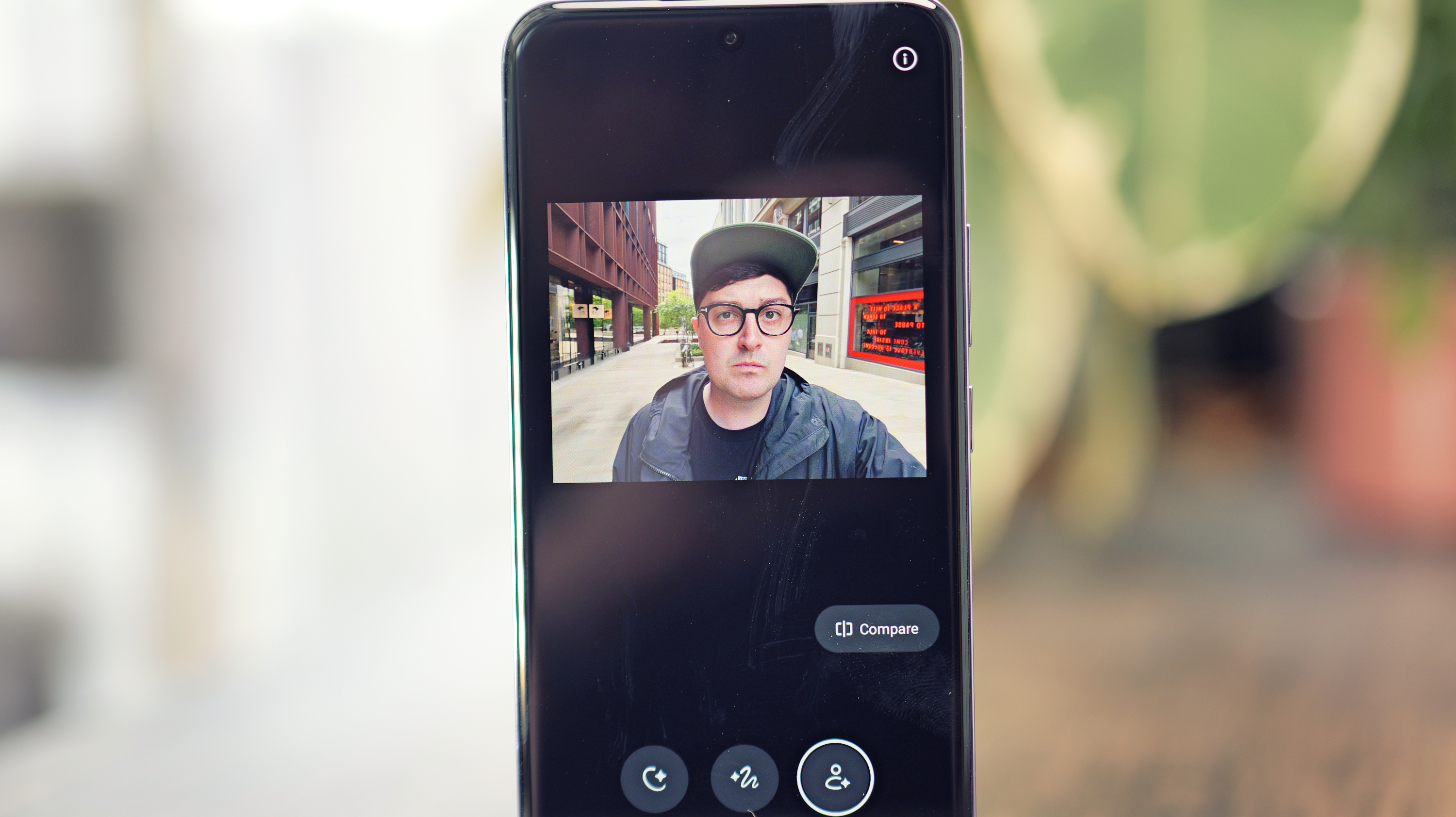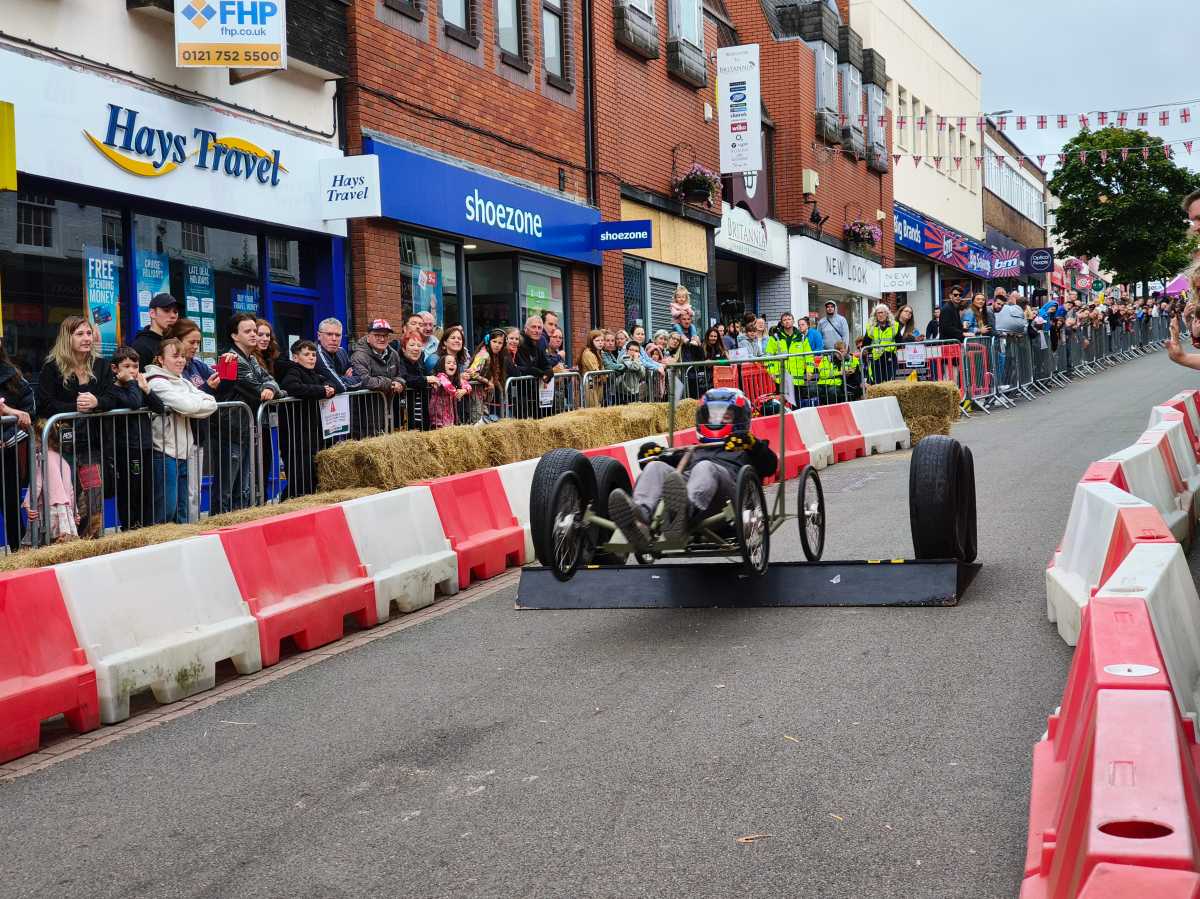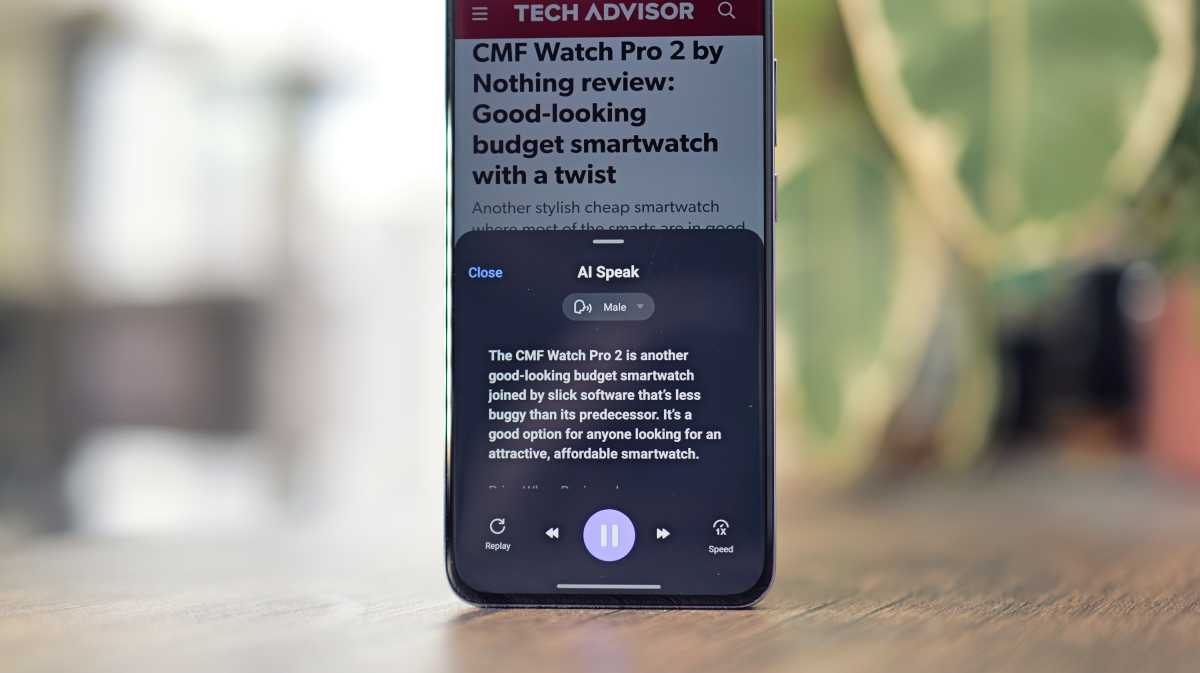Expert's Rating
Pros
- Unique eye-catching design
- Lovely quad-curved screen
- Handy AI features
- Speedy charging
Cons
- Cameras prone to motion blur
- Gaming performance isn’t great
- No charger in the box
Our Verdict
The Oppo Reno 12 Pro has a stylish design, lovely display, decent cameras and a suite of useful AI tools. It’s a great value option that’s easy to live with, but the relatively weak processor means that it’s not ideal for gaming.
Oppo’s Reno phones aim to deliver flagship-level specs and features at mid-range price points, and with the Reno 12 series, Oppo has set its sights firmly on AI.
Indeed, flagships from the likes of Samsung, Apple and Google are jam-packed with AI features in 2024, but if you’re not looking to spend the big bucks, your options are far more limited.
With the Reno 12 Pro, you get some of the most desirable AI features, like AI writing assistance, summarisation, photo editing and image generation – all for just £499, a fraction of the cost of most flagships.
It’s not all just AI trickery, either. The phone has a unique, stylish design, great display, big battery, speedy charging and impressive camera specs. On paper, it seems like a great deal, but what’s it like to live with? I’ve been carrying it around for the last few weeks to find out.
Design & Build
- Glass back, proprietary alloy framework
- 181g, Gorilla Glass Victus 2
- IP65 rated
The Oppo Reno 12 Pro stands out from the crowd with its unique rear panel, featuring a design that looks like ripples in a pool of metallic liquid. At least that’s the case with the Nebula Silver version that I’m testing, it’s also available in a far more subtle matte dark brown colourway without the ripple effect.

Luke Baker
If you like attention, the silver version is the way to go. It’s a really striking design that has garnered a lot of questions from friends and family members. I love the faint purple gradient, and the phone looks excellent when the light catches the ripples in the design.
The phone looks excellent when the light catches the ripples in the design
Despite the way it looks, there are no raised sections on the rear – it’s all one smooth glass panel with a velvety feel. It’s not too fingerprint prone, which I’m always happy to see, but it’s a little more slippery than I’d like. And since there’s no case included in the box, you’ll need to keep a firm grip on it at all times.
The frame has a high-gloss mirror finish with a slight purple tint. It appears to be made from plastic, but Oppo says there’s a proprietary alloy framework inside that keeps the phone protected from bending, dents and drops. It’s also IP65 rated to withstand dust and splashes of water.

Luke Baker
Around the front, the screen is protected by Gorilla Glass Victus 2 and it has quad micro-curved edges that are symmetrical on all sides. It reminds me of the display of the Xiaomi 14 Ultra, aiming to provide the best of both curved and flat displays.
The cameras are positioned in a Samsung-style traffic light orientation, and the lens protrusion is minimal by modern standards. It’s a fairly sizable phone, with a 6.7-inch display, but it feels comfortable in the hand, and it’s a touch slimmer and lighter than most flagships.
There’s no 3.5mm headphone socket, but you do get Micro-SD card support, which is something that’s becoming rare, even in the mid-range market.

Luke Baker
I found the haptic motors to be a little weak for my tastes, though. They do the job, but you don’t get the same mechanical-feeling clunk on keypresses like you do with pricier flagships.
It’s especially noticeable when you type quickly, as a lack of precision means that all the vibrations merge into one. Of course, that only matters if you’re used to a flagship model – the motors here easily compete with similarly-priced phones.
Screen & Speakers
- 120Hz 6.7-inch OLED display
- 1200 nits, 1080 x 2412 resolution
- Stereo speakers
The display of the Reno 12 Pro is a definite highlight. A combination of slim, mostly symmetrical bezels, quad-curved edges and a high brightness output make it one of my favourite displays in the mid-range market.

Luke Baker
The debate around flat displays vs curved edges rages on, but Oppo thinks its quad micro-curves offer the best of both worlds. I haven’t been shy about my preference for flat displays, but my experience with the Reno 12 Pro (and similar designs like the Xiaomi 14 Ultra and Huawei Pura 70 Ultra) has me eating my words.
The display of the Reno 12 Pro is a definite highlight
This design gives you a mostly flat panel to interact with, and the curves are restricted to the very borders of the panel, which is mainly filled with screen bezels rather than content. This means the reflections are kept away from the important part of the display, there’s no noticeable colour shifting, and you still get a nice smooth surface for gesture controls. I’m sold.

Luke Baker
As for the panel itself, it’s an OLED with a 120Hz refresh rate and an FHD+ resolution. As you’d expect, the contrast is excellent, the colours are vibrant and really pop, and the pixel density is high enough to make small text look sharp and legible.
The panel can boost to 1200 nits at peak brightness, which is enough to ensure that it’s visible on even bright sunny days. It’s not quite on the level of top-tier flagships when it comes to brightness, but it’s enough for most people’s needs, and I could always read it clearly, despite the British sunshine making a rare appearance.
The Reno 12 Pro supports HDR10+ playback and it looks superb on YouTube, especially if you toggle the “bright HDR video mode” on in the settings menu. Unfortunately, though, I couldn’t get Netflix working on my pre-release software. It’s an odd issue that wasn’t resolved by reinstalling the app, but I’m sure Oppo will have that ironed out soon enough.

Luke Baker
The Oppo Reno 12 Pro has dual stereo speakers positioned on the top and bottom of the device, allowing for a nice stereo effect when held in landscape mode. There’s a good bit of bass response and plenty of clarity, and they can get fairly loud, too. Just watch out if you push the volume past 100% and into “ultra volume mode”, which can introduce some distortion.
Overall, I’d say they’re a cut above most speakers in this price bracket, though.
Specs & Performance
- MediaTek Dimensity 7300 Energy
- 12GB RAM
- 512GB storage
The Oppo Reno 12 Pro runs on a new version of MediaTek’s Dimensity 7300 SoC developed in collaboration with Oppo, called the Dimensity 7300 Energy.
As the name suggests, this one’s all about efficiency, and Oppo says you can expect a 45% reduction in GPU power consumption compared to the Reno 10. This energy-efficient configuration might be great for battery life, but it’s not the best news for gamers.

Luke Baker
The chip is paired with a healthy 12GB of RAM and a generous 512GB of storage. That’s more than enough storage for most people, but if you need more, you can always pop in an Micro-SD card.
In general use, the phone feels responsive and nimble. Swiping around the operating system was mostly smooth, though I did notice the occasional animation stutter during heavy multitasking, and when the phone was first powered up. That said, it’s more than quick enough for casual users.
In general use, the phone feels responsive and nimble
However, when it comes to gaming, it’s not the most impressive showing.
Less graphically intensive games are no issue, but when I tried to play Genshin Impact, I had to stick to the lowest preset to achieve a stable 30fps. You can push it higher, but expect some jitters and slowdowns if you do. On the plus side, it never gets too hot under load.

Luke Baker
There’s a built-in game overlay that can be accessed by swiping from the left side of the display while a game is running. Switching to Pro Gamer mode will allow you to squeeze a few more frames per second from the chipset, but it’s not game-changing. There are some other handy features in here, though, including quick access to messaging apps and media playback controls.
Oppo Reno 12 Pro benchmarks
Cameras
- 50Mp main sensor
- 8Mp ultrawide
- 50Mp 2x telephoto
- 50Mp selfie camera
The Oppo Reno 12 Pro has a three-lens setup on the rear, comprised of a 50Mp 26mm equivalent main camera, a 50Mp 2x telephoto and an 8Mp 16mm equivalent ultrawide. Around the front, you get a selfie snapper with an impressive 50Mp resolution, a wide FOV and autofocus.
As usual, the main camera has the largest sensor of the bunch and delivers the most impressive results. It’s still only a 1/1.95-inch sensor, though, which means it’s not the most impressive in low-light conditions and has to rely on night mode more often than some of its photography-focused mid-range competition.
In the daylight, main lens photos look sharp and detailed, with vibrant colours that really pop.
The same is true for the 2x telephoto, which provides matching colours and a similar level of detail. You can get usable shots at up to 5x zoom, but pushing beyond that results in a very messy image full of artefacts.
The 8Mp ultrawide is less impressive. There’s a noticeable colour shift when using this lens and images look muddy and lack detail, especially when viewed on a larger display. There’s also no autofocus, so you can’t use it for any close-up shots.
The phone isn’t great at capturing motion, no matter which lens you use. I noticed quite a bit of blur on fast-moving subjects, even in good lighting, and the shutter lag makes it hard to get your timing right.
In the daylight, main lens photos look sharp and detailed, with vibrant colours that really pop
At night, you’ll want to stick to the main lens wherever possible, as the larger sensor results in less noise and quicker exposure times. The other lenses are usable, aided by night mode, but there’s a much higher risk of motion blur. The ultrawide is particularly bad in the dark, delivering some very grainy results.
The selfie camera is excellent in the daylight. It captures sharp detail and good skin tones, while the wide FOV and autofocus make it great for group shots. At night, this lens also struggles with motion blur, but if you can keep a steady enough hand, it’s capable of good results.
For video shooting, the Reno 12 Pro offers up to 4K 30fps capture on all cameras excluding the ultrawide, which maxes out at 1080p 30fps. You can shoot at 60fps on the main, telephoto and selfie camera but only in 1080p.
The video quality is good, with decent stabilisation that can be enhanced further by selecting ‘Ultra Steady Mode’. Autofocus is quick and reliable, but you can’t switch between lenses while recording, which is something I always find frustrating.
Battery Life & Charging
- 5000 mAh battery
- 80W wired charging
- No charger included
The Oppo Reno 12 Pro packs in a 5000mAh battery. Combined with its efficient chipset, I had high hopes for the battery life.
In reality, it’s slightly above average, but it’s nothing astonishing. It’ll easily see you through a day of heavy use with a bit to spare, but you’re not likely to get two days from a charge. Still, that’s more than enough juice for most people, and with speedy charging support, topping it up is barely an inconvenience.
With speedy charging support, topping it up is barely an inconvenience
The Reno 12 Pro can charge at up to 80W, which Oppo says is fast enough to get you from flat to full in 46 minutes. Unfortunately, there’s no charger in the box, and as usual, you’ll need Oppo’s official charger to get the maximum speed.

Luke Baker
What’s more interesting though, is that Oppo has added support for 55W PD charging, so you’ll still get a speedy charge from third-party wall adapters and power banks. I used my Ugreen Nexode 300W multi-charger, which was able to deliver a 51% charge in just 30 minutes.
There’s no support for wireless charging, which isn’t unusual in the price bracket, but would’ve been nice to see. The likes of Google and Nothing are managing to include wireless charging on similarly priced devices, so hopefully it’ll become more common in the future.
Software & Apps
- ColorOS 14.1, based on Android 14
- Lots of AI features
- Some bloatware
The Oppo Reno 12 Pro runs ColorOS 14.1, which is a skinned version of Android 14.
There are a few stylistic changes, but on the whole, it doesn’t stray too far from the stock Android experience. Everything is where you expect it to be: there’s an app drawer and Google Discover tab, and it’s very easy to navigate. Having spent a lot of time with phones from sister companies OnePlus and Vivo, I felt immediately at home.
What’s different with this phone is the addition of numerous AI-powered tools, similar to those that you’ll find on Samsung’s latest flagships. Two of my favourite features live in the smart sidebar and can be accessed by swiping from the upper-right side of the display. They’re both tools that help with reading articles, and are excellent if you’re short on time or trying to multitask.
AI Speak reads out any article you have open in your browser in a natural-sounding voice. It’s very handy if you want to read an article but you aren’t able to stare at your screen, like when you’re commuting.
The downside is that it reads out all page content, and will include things like menus from time to time. AI Summary will read the displayed article and spit out a series of concise bullet points, so you can get the key info without having to read the whole thing.
There’s a similar feature built-in to the recorder app. You can record meetings, conversations or voice memos, and the AI will transcribe the audio and can also create a summary. There’s also an AI writing assistant that can help you craft tweets, Instagram descriptions and emails – it’ll even auto-generate emojis and hashtags.
On the image editing side of things, AI tools allow you to create generative AI illustrations based on your photos, clean up blurry faces in group selfies, erase unwanted objects and people from your photos.


Soon, you’ll also be able to swap faces in group photos, just like Google Pixel’s Best Take feature. That last one is promised as a future software update, while a full AI chatbot is supposedly on the way, too.
Price & Availability
The Oppo Reno 12 Pro is available now in the UK and Europe with a retail price of £499/€549.
At the time of writing, it only seems to be available through Oppo’s website with no contract deals, so if you decide to pick one up, our guide to the best SIM-only deals or choose something that you like the look of below.
There’s only one configuration available in the European market, offering 12GB of RAM and 512GB of storage.
The Reno 12 Pro’s pricing puts it in direct competition with mid-range heavy hitters like the Google Pixel 8a (from £499), OnePlus Nord 4 (from £429), Redmi Note 13 Pro+ (£449) and Poco F6 Pro (from £499.90). If you want to see how it compares, you can read our full guide to the best mid-range phones.
Should you buy the Oppo Reno 12 Pro?
The Oppo Reno 12 Pro has been a delight to live with. The screen is excellent, the design is unique and eye-catching, the software is easy to use and the AI features come in quite handy.
The cameras are good in the daylight, and I was particularly impressed with the selfie camera. However, in low light and with fast-moving subjects, they leave a little to be desired. The gaming performance is slightly lacking, too – it gets the job done, but isn’t likely to wow you.
Whether this phone is right for you all depends on your priorities. If you’re keen on AI-powered productivity, it’s one of the best options in its price bracket.
However, if you’re an avid photographer, the Pixel 8a often delivers better results, and if gaming is a high priority, I’d recommend looking at the Poco F6 Pro instead.
Specs
- ColorOS 14.1, based on Android 14
- 6.7-inch, 2412×1080, OLED, 120Hz
- In-display fingerprint sensor
- MediaTek Dimensity 7300 Energy
- 12GB RAM
- 512GB storage
- Cameras:
- 50Mp main sensor
- 8Mp ultrawide
- 50Mp 2x telephoto
- 50Mp selfie camera
- Up to 4K @ 30fps rear video
- Stereo speakers
- Dual-SIM
- MicroSD card slot
- Wi-Fi 802.11 a/b/g/n/ac/ax
- Bluetooth 5.4
- 5000mAh battery
- 80W charging
- 161.5 x 74.8 x 7.4 mm
- IP65 certified
- 181g
- Colours: Space Brown, Nebula Silver

























